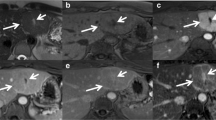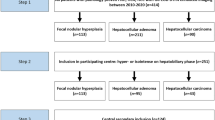Abstract
Objectives
Sonic hedgehog hepatocellular adenoma (shHCA) is a new hepatocellular adenoma (HCA) subgroup characterized by high risk of hemorrhage. ShHCA account for below 10% of all HCA cases and are often associated with female gender, obesity, and non-alcoholic steatohepatitis. No specific MRI characteristics have been described to date. The objective of this study was to assess the value of using MRI to identify shHCA, and correlate MRI findings with histology.
Methods
We retrospectively collected MRI scans of 29 patients with shHCA from our center and from different liver referral centers to include 35 lesions. Diagnosis of shHCA was assessed by immunohistochemical overexpression of argininosuccinate synthase 1 or prostaglandin D2 synthase, then confirmed by molecular analysis of sonic hedgehog pathway activation and/or by proteomic analysis.
Results
In 46% (n = 16/35) of shHCA cases, we detected intralesional fluid-filled cavities defined on MR images as fluid-like foci markedly hyperintense on T2-weighted sequences, and hypointense on T1-weighted sequences, with or without delayed enhancement. Pathologically, these cavities were observed in 54% of cases as vacuoles filled with blood at different stages of degradation. Hemorrhage and/or necrosis were detected among 71% of cases by MRI analysis (n = 25/35) versus 82% pathologically. Seventeen percent of shHCA cases (n = 6/35) were completely homogeneous via MRI and pathological analysis. No MRI criteria was found in favor of focal nodular hyperplasia, HNF1A-mutated HCA, or typical inflammatory HCA.
Conclusion
We reveal the presence of intralesional fluid-filled cavities among 46% of our shHCA cases that represent a new MRI finding possibly helpful for shHCA diagnosis.
Clinical relevance statement
This multicenter study is the first clinical study about the radiological aspect of this new hepatocellular adenoma subgroup. This highlights a strong correlation between MRI and histological analysis, with a specific pattern emerging for diagnosis.
Key Points
• Sonic hedgehog hepatocellular adenoma is a new hepatocellular adenoma subgroup associated with high risk of hemorrhage, but imaging features of this subgroup remain unknown.
• Analysis of MR images and correlation with pathology revealed intralesional fluid-filled cavities and necrotic-hemorrhagic changes.
• Intralesional fluid-filled cavities have not yet been described in other adenoma subtypes and represent a new MRI finding for sonic hedgehog hepatocellular adenoma.






Similar content being viewed by others
Abbreviations
- ASS1:
-
Argininosuccinate synthase
- b-HCA:
-
Beta-catenin-mutated hepatocellular adenoma
- bIHCA:
-
Beta-catenin-mutated and inflammatory hepatocellular adenoma
- CRP:
-
C-reactive protein
- FNH:
-
Focal nodular hyperplasia
- GS:
-
Glutamine synthase
- HCA:
-
Hepatocellular adenoma
- HCC:
-
Hepatocellular carcinoma
- H-HCA:
-
HNF1A-mutated hepatocellular adenoma
- HNF1A:
-
Hepatocyte nuclear factor 1A
- IHCA:
-
Inflammatory hepatocellular adenoma
- INHBE:
-
Inhibin beta E chain
- LFABP:
-
Liver fatty acid binding protein
- NA:
-
Non-available
- NASH:
-
Non-alcoholic steatohepatitis
- NT:
-
Non-tumoral
- OC:
-
Oral contraception
- PTGDS:
-
Prostaglandin D2 synthase
- sh:
-
Sonic hedgehog
- shHCA:
-
Sonic hedgehog hepatocellular adenoma
- UHCA:
-
Unclassified hepatocellular adenoma
References
Rooks JB, Ory HW, Ishak KG et al (1979) Epidemiology of hepatocellular adenoma The role of oral contraceptive use. JAMA 2427:644–8
Nault JC, Bioulac-Sage P, Zucman-Rossi J (2013) Hepatocellular benign tumors-from molecular classification to personalized clinical care. Gastroenterology 144(5):888–902
van Aalten SM, de Man RA, IJzermans JNM, Terkivatan T (2012) Systematic review of haemorrhage and rupture of hepatocellular adenomas. Br J Surg 99(7):911–6
Dokmak S, Paradis V, Vilgrain V et al (2009) A single-center surgical experience of 122 patients with single and multiple hepatocellular adenomas. Gastroenterology 137(5):1698–705
Nault JC, Couchy G, Balabaud C et al (2017) Molecular classification of hepatocellular adenoma associates with risk factors, bleeding, and malignant transformation. Gastroenterology 152(4):880-894.e6
Bioulac-Sage P, Sempoux C, Balabaud C (2017) Hepatocellular adenoma: classification, variants and clinical relevance. Semin Diagn Pathol 34(2):112–25
Bayard Q, Caruso S, Couchy G et al (2020) Recurrent chromosomal rearrangements of ROS1, FRK and IL6 activating JAK/STAT pathway in inflammatory hepatocellular adenomas. Gut 69(9):1667–76
Rebouissou S, Franconi A, Calderaro J et al (2016) Genotype-phenotype correlation of CTNNB1 mutations reveals different ß-catenin activity associated with liver tumor progression. Hepatology 64(6):2047–61
Omenetti A, Choi S, Michelotti G, Diehl AM (2011) Hedgehog signaling in the liver. J Hepatol 54(2):366–73
Sala M, Gonzales D, Leste-Lasserre T et al (2020) ASS1 overexpression: a hallmark of sonic hedgehog hepatocellular adenomas. Recommendations for Clinical Practice. Hepatol Commun 4(6):809–24
European Association for the Study of the Liver (EASL). EASL Clinical Practice Guidelines on the management of benign liver tumours. J Hepatol 2016 65 (2) 386‑98
Bioulac-Sage P, Gouw ASH, Balabaud C, Sempoux C (2022) Hepatocellular adenoma: what we know, what we do not know, and why it matters. Histopathology 80(6):878–97
Julien C, Le-Bail B, Ouazzani Touhami K et al (2021) Hepatocellular adenoma risk factors of hemorrhage: size is not the only concern!: Single-center Retrospective Experience of 261 Patients. Ann Surg 274(5):843–850
Henriet E, Abou Hammoud A, Dupuy JW et al (2017) Argininosuccinate synthase 1 (ASS1): a marker of unclassified hepatocellular adenoma and high bleeding risk. Hepatology 66(6):2016–28
Laumonier H, Bioulac-Sage P, Laurent C, Zucman-Rossi J, Balabaud C, Trillaud H (2008) Hepatocellular adenomas: magnetic resonance imaging features as a function of molecular pathological classification. Hepatology 48(3):808–18
van Aalten SM, Thomeer MGJ, Terkivatan T et al (2011) Hepatocellular adenomas: correlation of MR imaging findings with pathologic subtype classification. Radiology 261(1):172–81
Zulfiqar M, Sirlin CB, Yoneda N et al (2020) Hepatocellular adenomas: understanding the pathomolecular lexicon, MRI features, terminology, and pitfalls to inform a standardized approach. J Magn Reson Imaging 51(6):1630–40
Reizine E, Ronot M, Ghosn M et al (2021) Hepatospecific MR contrast agent uptake on hepatobiliary phase can be used as a biomarker of marked β-catenin activation in hepatocellular adenoma. Eur Radiol 31(5):3417–26
Frulio N, Balabaud C, Laurent C, Trillaud H, Bioulac-Sage P (2019) Unclassified hepatocellular adenoma expressing ASS1 associated with inflammatory hepatocellular adenomas. Clin Res Hepatol Gastroenterol 43(5):e63-7
Bise S, Frulio N, Hocquelet A et al (2019) New MRI features improve subtype classification of hepatocellular adenoma. Eur Radiol. 29(5):2436–47
Bieze M, Phoa SSKS, Verheij J, van Lienden KP, van Gulik TM (2014) Risk factors for bleeding in hepatocellular adenoma. Br J Surg 101(7):847–55
Bioulac-Sage P, Laumonier H, Couchy G et al (2009) Hepatocellular adenoma management and phenotypic classification: the Bordeaux experience. Hepatology 50(2):481–9
Dokmak S, Aussilhou B, Rasoaherinomenjanahary F et al (2018) Hemorrhage of hepatocellular adenoma: a complication that can be treated by conservative management without surgery. HPB (Oxford) 20(12):1198–205
Erdogan D, van Delden OM, Busch ORC, Gouma DJ, van Gulik TM (2007) Selective transcatheter arterial embolization for treatment of bleeding complications or reduction of tumor mass of hepatocellular adenomas. Cardiovasc Intervent Radiol 30(6):1252–8
Dourthe C, Julien C, Di Tommaso S et al (2021) Proteomic profiling of hepatocellular adenomas paves the way to diagnostic and prognostic approaches. Hepatology 74(3):1595–610
Acknowledgements
The authors would like to thank clinician, pathologist, and molecular biologist colleagues from Bordeaux, Paris, Lausanne, and Groningen as well as Dr. Frederic Saltel and Dr. Anne Aurélie Raymond (Bordeaux research laboratory Inserm BRIC, U1312) for their fruitful discussion.
Funding
The authors state that this work has not received any funding.
Author information
Authors and Affiliations
Corresponding author
Ethics declarations
Guarantor
The scientific guarantor of this publication is Nora Frulio.
Conflict of interest
The authors of this manuscript declare no relationships with any companies, whose products or services may be related to the subject matter of the article.
Sabine Schmidt-Kobbe is European Radiology’s section editor of the Scientific Editorial Board for Gastrointestinal-Abdominal. She has not taken part in the review or selection process of this article.
Statistics and biometry
No complex statistical methods were necessary for this paper.
Informed consent
Written informed consent was waived by the Institutional Review Board.
Ethical approval
Institutional Review Board approval was obtained (CHU Bordeaux).
Study subjects or cohorts overlap
Some study subjects or cohorts have been previously published in [1, 2].
1. Sala M, Gonzales D, Leste-Lasserre T, et al. (2020) ASS1 overexpression: a hallmark of sonic hedgehog hepatocellular adenomas; Recommendations for Clinical Practice. Hepatol Commun. 4(6):809-824. https://doi.org/10.1002/hep4.1514
2. Dourthe C, Julien C, Di Tommaso S, et al (2021) Proteomic profiling of hepatocellular adenomas paves the way to diagnostic and prognostic approaches. Hepatology.74(3):1595-1610. https://doi.org/10.1002/hep.31826
Methodology
• retrospective
• observational
• multicenter study
Additional information
Publisher's Note
Springer Nature remains neutral with regard to jurisdictional claims in published maps and institutional affiliations.
Rights and permissions
Springer Nature or its licensor (e.g. a society or other partner) holds exclusive rights to this article under a publishing agreement with the author(s) or other rightsholder(s); author self-archiving of the accepted manuscript version of this article is solely governed by the terms of such publishing agreement and applicable law.
About this article
Cite this article
Ducatel, A., Trillaud, H., Reizine, E. et al. Sonic hedgehog hepatocellular adenoma: magnetic resonance imaging features and correlation with histology. Eur Radiol 34, 4649–4662 (2024). https://doi.org/10.1007/s00330-023-10344-5
Received:
Revised:
Accepted:
Published:
Issue Date:
DOI: https://doi.org/10.1007/s00330-023-10344-5




